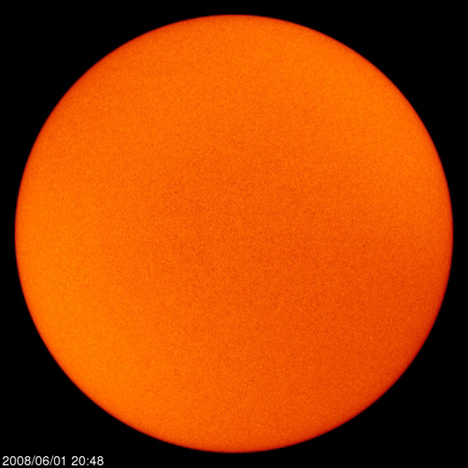Our spotless sun
By Lawrence Solomon, Financial Post, May 31, 2008

Solar image of June 1, 2008 courtesy Solar and Heliospheric Observatory [here]. Note the continuing absence of sunspots, giving rise to speculation that another Little Ice Age looms.
You probably haven’t heard much of Solar Cycle 24, the current cycle that our sun has [not yet - ed.] entered, and I hope you don’t. If Solar Cycle 24 becomes a household term, your lifestyle could be taking a dramatic turn for the worse. That of your children and their children could fare worse still, say some scientists, because Solar Cycle 24 could mark a time of profound long-term change in the climate. As put by geophysicist Philip Chapman, a former NASA astronaut-scientist and former president of the National Space Society, “It is time to put aside the global warming dogma, at least to begin contingency planning about what to do if we are moving into another little ice age.”
The sun, of late, is remarkably free of eruptions: It has lost its spots. By this point in the solar cycle, sunspots would ordinarily have been present in goodly numbers. Today’s spotlessness — what alarms Dr. Chapman and others — may be an anomaly of some kind, and the sun may soon revert to form. But if it doesn’t – and with each passing day, the speculation in the scientific community grows that it will not – we could be entering a new epoch that few would welcome.
Sunspots have been well documented throughout human history, starting in the fourth century BC, with written descriptions by Gan De, a Chinese astronomer. In 1128, an English monk, John of Worcester, was the first person known to have drawn sunspots, and after the telescope’s arrival in the early 1600s, observations and drawings became commonplace, including by such luminaries as Galileo Galilei. Then, to the astonishment of astronomers, they saw the sunspots diminish and die out altogether.
This was the case during the Little Ice Age, a period starting in the 15th or 16th century and lasting centuries, says NASA’s Goddard Space Centre, which links the absence of sunspots to the cold that then descended on Earth. During the coldest part of the Little Ice Age, a time known as the Maunder Minimum (named after English astronomer Edward Maunder), astronomers saw only about 50 sunspots over a 30-year period, less than one half of 1% of the sunspots that would normally have been expected. Other Minimums — times of low sunspot activity — also corresponded to times of unusual cold. … [more]
Note: Solar Cycle 24 is now one year overdue (based on average solar cycle length of 11 years). See Ultralong Solar Cycle 23 and Possible Consequences by Joe D’Aleo [here]